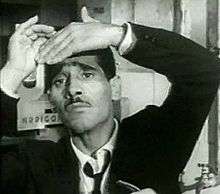Tiberio Murgia
Tiberio Murgia (5 February 1929 – 20 August 2010)[1] was an Italian film actor. He appeared in more than 100 films between 1958 and 2009.
Tiberio Murgia | |
|---|---|
 | |
| Born | 5 February 1929 Oristano, Italy |
| Died | 20 August 2010 (aged 81) Tolfa, Italy |
| Occupation | Actor |
| Years active | 1958-2009 |
Biography
Born into a humble family, Murgia began working as a laborer from an early age. At the age of twenty he was already a peddler for l'Unità, the newspaper of the Italian Communist Party. The managing directors of the local branch of the party recognized particular political skills in him and send him to Frattocchie, in the province of Rome, where the headquarters of the National School for the party leaders were. After his return, six months later, he became the Secretary of the Young Communist League and got married. After some time, however, Murgia began to entertain a relationship with a comrade of the party. Murgia was then expelled because of this clandestine affair—he already married and father—with the woman, who was also married.
Murgia then emigrated to Marcinelle, in Belgium, to work at the Bois du Cazier coalmine which had several thousands of Italian workers as miners, due to the Italian Belgian Protocol of 20 June 1946. There also Murgia established a relationship with the wife of a Belgian coworker and escaped death—in an almost fictional way—that fatal night of the Marcinelle mining disaster, in which a gas explosion killed all the miners of his shift, including the woman's husband. As a matter of fact Murgia was on a fake sick leave from work in order to spend the night with the woman.
Murgia returned to his hometown, Oristano, but was forced to emigrate to Rome in order to escape the wrath of the family of another young woman which he wooed despite both of them being already married. In Rome he began working as a dishwasher in a restaurant in the city center (Il re degli Amici, the king of friends) until he was noticed by an assistant of the director Mario Monicelli, who invited him to the studio for an audition after which he was given the part. Since originally his first movie was called "The Madame"—before the censorship imposed the change of title to "Big Deal on Madonna Street"—he did not even know the film in which he starred was already in the theatres. He had found himself a job at a construction site at Ponte Milvio, when the production team miraculously tracked him down to give him a contract and an advance of ten million.
Following the success of the Monicelli's film, Murgia later acted in about 150 films, usually repeating his first character with slight variations (always playing as sicilian while he was from Sardinia); his films span from several masterpieces of the Commedia all'italiana to genre films, especially Italian sex comedy and musicarelli.
Selected filmography
- Big Deal on Madonna Street (1958)
- Il raccomandato di ferro (1959)
- Audace colpo dei soliti ignoti (1960)
- Fountain of Trevi (1960)
- The Two Rivals (1960)
- L'onorata società (1961)
- Damon and Pythias (1962)
- I Don Giovanni della Costa Azzurra (1962)
- Three Nights of Love (1964)
- L'homme orchestre (1970)
- Paulo Roberto Cotechiño centravanti di sfondamento (1983)
- Big Deal After 20 Years (1987)
- Breath of Life (1990)
References
- "Cinema: e' morto Tiberio Murgia". ansa.it. Retrieved 21 August 2010.